
Central Sulawesi is a province of Indonesia located at the centre of the island of Sulawesi. The administrative capital and largest city is located in Palu. The 2010 census recorded a population of 2,635,009 for the province, and the 2015 Census of 2,876,689, while the latest official estimate is 3,042,100. Central Sulawesi has an area of 61,841.29 km2 (23,877 sq mi), the largest area among all provinces on Sulawesi Island, and has the second-largest population on Sulawesi Island after the province of South Sulawesi. It is bordered by the provinces of Gorontalo to the north, West Sulawesi, South Sulawesi and South East Sulawesi to the south, by Maluku to the east, and by the Makassar Strait to the west. The province is inhabited by many ethnic groups, such as the Kaili, Tolitoli, etc. The official language of the province is Indonesian, which is used for official purposes and inter-ethnic communication, while there are several indigenous language spoken by the Indigenous peoples of Central Sulawesi. Islam is the dominant religion in the province, followed by Christianity which are mostly adhered by the people in the eastern part of the province.
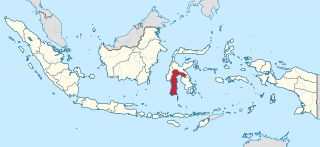
South Sulawesi is a province in the southern peninsula of Sulawesi. The Selayar Islands archipelago to the south of Sulawesi is also part of the province. The capital is Makassar. The province is bordered by Central Sulawesi and West Sulawesi to the north, the Gulf of Bone and Southeast Sulawesi to the east, Makassar Strait to the west, and Flores Sea to the south.

Pendet is a traditional dance from Bali, Indonesia, in which floral offerings are made to purify the temple or theater as a prelude to ceremonies or other dances. Pendet is typically performed by young girls, carrying bowls of flower petals, handfuls of which are cast into the air at various times in the dance. Pendet can be thought of as a dance of greeting, to welcome the audience and invite spirits to enjoy a performance. It is one of the oldest Balinese dance, although the current form was codified in the 1950s.

Topeng is a dramatic form of Indonesian dance in which one or more mask-wearing, ornately costumed performers interpret traditional narratives concerning fabled kings, heroes and myths, accompanied by gamelan music.
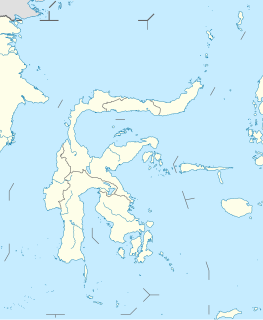
The South Peninsula is one of the four principal peninsulas on the island of Sulawesi, stretching south from the central part of the island. It is part of the province of South Sulawesi. The southern peninsula is the most densely populated peninsula in Sulawesi; over 45% of the population of Sulawesi are on the southern peninsula. Inhabited by an Austronesian people who came thousands of years ago. The largest ethnic group in Sulawesi is the Bugis, followed by Makassar and Toraja.
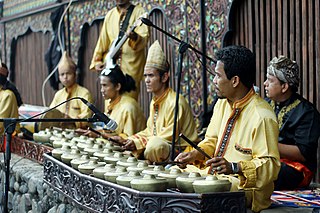
Talempong is a traditional music of the Minangkabau people of West Sumatra, Indonesia. The talempong produce a static texture consisting of interlocking rhythms.

Balinese dance is an ancient dance tradition that is part of the religious and artistic expression among the Balinese people of Bali island, Indonesia. Balinese dance is dynamic, angular and intensely expressive. Balinese dancers express the stories of dance-drama through the bodily gestures including gestures of fingers, hands, head and eyes.
Coppong Daeng Rannu is a master of Makassar ethnic-group dances. She is best known as Rice Goddess in performance I La Galigo.

Dance in Indonesia reflects the country's diversity of ethnicities and cultures. There are more than 300 ethnic groups in Indonesia: Austronesian roots and Melanesian tribal forms are visible, and influences ranging from neighbouring Asian and even western styles through colonisation. Each ethnic group has its own dances: there are more than 3,000 original dance forms in Indonesia. The old traditions of dance and drama are being preserved in the many dance schools which flourish not only in the courts but also in the modern, government-run or supervised art academies.
Wajoq, also spelled Wajo, Wajo', or Wajok, was a Bugis elective principality in the western part of the South Sulawesi peninsula. It was founded in the 15th century, and reached its peak in the 18th century, when it briefly became the hegemon of South Sulawesi replacing Boné. Wajoq retained its independence until it was subdued in the early 20th century by the Dutch colonial government. It continued to exist in some form up to mid-20th century, when the self-governing entity was transformed into Wajo Regency in the newly independent Republic of Indonesia.
I La Galigo is music-theater work by Robert Wilson that has been shown since 2004 in Asia, Europe, Australia and the United States. It is based on an adaption by Rhoda Grauer of the epic creation myth Sureq Galigo of the Bugis from South Sulawesi, written between the 13th and 15th century in the Indonesian language Buginese.

Gowa is a regency in the province of South Sulawesi, Indonesia. It has an area of 1,883 km² and a population of 652,329 at the 2010 Census; the latest official estimate is 751,981. The majority of the Regency lies within the official metropolitan area of the city of Makassar, including the regency's administrative capital at Sungguminasa. The hill resort of Malino is within the eastern (non-metropolitan) part of the regency.
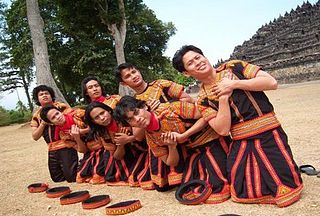
Saman is one of the most popular dances in Indonesia. Its origin is from the Gayo ethnic group from Gayo Lues, Aceh province, Indonesia, and is normally performed to celebrate important occasions. The dance is characterized by its fast-paced rhythm and common harmony between dancers. These two elements are key figures of Saman, and are among the reasons Saman are widely known and practiced in Indonesia, besides being relatively easy to learn.
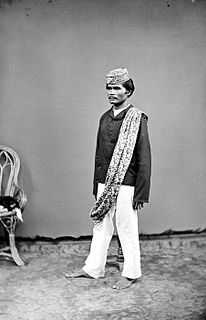
The Makassar people are an ethnic group that inhabits the southern part of the South Peninsula, Sulawesi in Indonesia. They live around Makassar, the capital city of the province of South Sulawesi, as well as the Konjo highlands, the coastal areas, and the Selayar and Spermonde islands. They speak Makassarese, which is closely related to Buginese and also a Malay creole called Makassar Malay.
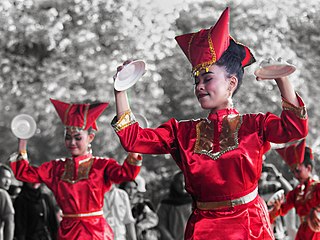
Tari Piring is a traditional Minangkabau plate dance from West Sumatra, Indonesia. The dance might be performed by a group of women, men or couples, each of them holds plates in each hands, and vigorously rotate or half rotate them in various formations and fast movements.
The 3rd Kostrad Infantry Division abbreviated "Divif 3/Kostrad", is an army strategic command division of the Indonesian Army. The divisional commander is a two-star Major General. The division's headquarters are in Gowa. It is the youngest of all the infantry divisions of the Kostrad.

Pajoge dance is a traditional dance of the Buginese and Makassar people who came from Bone, South Sulawesi, Indonesia. The term Pajoge has three meanings at once. From the word joge which means a dance, while pa joge to refer to a dancer, as well as a show. Although different, but the three meanings are one entity.

Paraga dance is a traditional dance of the Bugis and Makassar tribes originating from South Sulawesi, Indonesia. This dance is played by 6 men in passapu traditional clothes by showing attractions in playing Bola raga or also called Sepak takraw. Paraga dance plays a ball with the construction of the ball moving from foot to foot, is the actualization of a'rannu-rannu, an activity carried out during leisure time, or in other words, playing and having fun.

Tortor dance is a traditional Batak ancient type dance originating from North Sumatra, Indonesia. Tortor is a ceremonial dance that is presented with gondang music. Physically, tortor is a dance, but the meaning that is more than just its movements shows that tortor is a communication medium, where through the movements that are presented, there is interaction between the ceremonial participants.
















